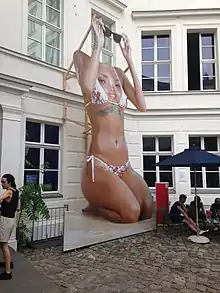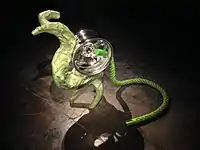Post-Internet
Post-Internet is a 21st century art movement[1] involving works that are derived from the Internet or its effects on aesthetics, culture and society.[2]
.jpg.webp)
Definition
Post-Internet is a loosely-defined term[1] that was coined by artist/curator by Marisa Olson in attempts to describe her practice.[3] It emerged from mid-2000s discussions about Internet art by Gene McHugh (author of a blog titled "Post-Internet"), and Artie Vierkant (artist, and creator of Image Object sculpture series).[4] The movement itself grew out of Internet Art (or Net Art).[4] According to the UCCA Center for Contemporary Art, rather than referring "to a time “after” the internet", the term refers to "an internet state of mind".[5]
The term is controversial and the subject of much criticism in the art community.[1] Art in America's Brian Droitcour opined that the term fails to describe the form of the works, instead "alluding only to a hazy contemporary condition and the idea of art being made in the context of digital technology."[6] According to a 2015 article in The New Yorker, the term describes "the practices of artists [whose] artworks move fluidly between spaces, appearing sometimes on a screen, other times in a gallery."[7] Fast Company's Carey Dunne summarizes they are "artists who are inspired by the visual cacophony of the web" and notes that "mediums from Second Life portraits to digital paintings on silk to 3-D-printed sculpture" are used.[3]
There is theoretical overlap with James Bridle's term New Aesthetic.[8][2] Ian Wallace writes that "the influential blog The New Aesthetic, run since May 2011 by writer and artist James Bridle, is a pioneering institution in the post-Internet movement" and concludes that "much of the energy around the New Aesthetic seems, now, to have filtered over into the "post-Internet" conversation."[2] Post-Internet art is also discussed by Katja Novitskova as being a part of 'New Materialism'.[9][10]
Ian Wallace of Artspace considers the Post-Internet term to stand for "a new aesthetic era," moving "beyond making work dependent on the novelty of the Web to using its tools to tackle other subjects". He notes that the post-Internet generation "frequently uses digital strategies to create objects that exist in the real world."[2] Or as Louis Doulas writes in Within Post-Internet, Part One (2011): "There is a difference then, in an art that chooses to exist outside of a browser window and an art that chooses to stay within it."[11]
Influence

The movement spearheaded microgenres and subcultures such as seapunk and vaporwave.[1] In the early 2010s, "post-Internet" was popularly associated with the musician Grimes. Grimes used the term to describe her work at a time when post-Internet concepts were not typically discussed in mainstream music arenas.[12] Amarco referred to Yung Lean as "by and large a product of the internet and a leading example of a generation of youths who garner fame through social media."[1]
Exhibitions
There have been a number of significant group shows explicitly exploring Post-Internet themes. There was a 2014 exhibition called Art Post-Internet at Beijing's Ullens Center for Contemporary Art, which "set out to encapsulate the budding movement."[2] MoMa curated Ocean of Images (2015), a show "probing the effects of an image-based post-Internet reality."[13] The 2016 9th Berlin Biennale, titled The Present in Drag, curated by the art collective DIS, is described as a Post-Internet exhibition.[14][15][16]
- Raster Raster, Aran Cravey Gallery, Los Angeles, 2014[17]
- 2015 Triennial: Surround Audience at New Museum, New York, 2015[18]
- Zero Zero, Annka Kulty Gallery, London, 2016[19]
Notable artists
Gallery
 Installation view of Katja Novitskova at KUMU Art Museum of Estonia, Tallinn, 2016
Installation view of Katja Novitskova at KUMU Art Museum of Estonia, Tallinn, 2016
 Anna Uddenberg at the 9th Berlin Biennale, 2016.
Anna Uddenberg at the 9th Berlin Biennale, 2016..jpg.webp) GCC collective at the 9th Berlin Biennale, 2016.
GCC collective at the 9th Berlin Biennale, 2016. Guan Xiao at the 9th Berlin Biennale, 2016.
Guan Xiao at the 9th Berlin Biennale, 2016. Part of Artie Vierkant's Image Objects series.
Part of Artie Vierkant's Image Objects series. Photo by DIS. Fair Trade, Frieze Projects 2012
Photo by DIS. Fair Trade, Frieze Projects 2012
References
- Amarca, Nico (March 1, 2016). "From Bucket Hats to Pokémon: Breaking Down Yung Lean's Style". High Snobiety. Retrieved May 24, 2020.
- Wallace, Ian (March 18, 2014). "What Is Post-Internet Art? Understanding the Revolutionary New Art Movement". Artspace.
- Dunne, Carey (2014-03-10). "9 Post-Internet Artists You Should Know". Fast Company. Retrieved 2021-01-26.
- Connor, Michael (November 1, 2013). "What's Postinternet Got to do with Net Art?". Rhizome.
- "Art Post-Internet". UCCA Center for Contemporary Art. Retrieved 2021-01-23.
- Droitcour, Brian; Droitcour, Brian (2014-10-29). "The Perils of Post-Internet Art". ARTnews.com. Retrieved 2021-01-26.
- Kenneth, Goldsmith (2015-03-10). "Post-Internet Poetry Comes of Age". The New Yorker. Retrieved 2016-09-14.
- "The New Aesthetic and its Politics | booktwo.org". Retrieved 2021-01-24.
- "Post-Internet Materialism Martijn Hendriks & Katja Novitskova - Features - Metropolis M". www.metropolism.com. Retrieved 2021-01-24.
- "Katja Novitskova's Work In A Post-Internet World – the Future In A Mediated Reality < 1/2015 < Issues - kunst.ee". ajakirikunst.ee. Retrieved 2021-01-24.
- Doulas, Louise (2011). Within Post-Internet, Part One. pooool.info.
- Snapes, Laura (February 19, 2020). "Pop star, producer or pariah? The conflicted brilliance of Grimes". The Guardian.
- "Ocean of Images: New Photography 2015 | MoMA". The Museum of Modern Art. Retrieved 2021-02-01.
- "You missed the 9th Berlin Biennale". showerofkunst.com. Retrieved 2020-12-15.
- "DIS – the post-internet collective Curating the 9th Berlin Biennale". fineartmultiple.com. Retrieved 2021-01-25.
- ""Die Stadt ist internationaler geworden" | Monopol". www.monopol-magazin.de (in German). Retrieved 2021-02-01.
- ""Raster Raster" at Aran Cravey Gallery, Los Angeles •". Mousse Magazine (in Italian). 2014-04-07. Retrieved 2021-01-26.
- "2015 Triennial: Surround Audience at the New Museum". DAILY SERVING. Retrieved 2021-01-26.
- "Exhibition // 'Zero Zero' Proposes A New Post-Internet Landscape". Berlin Art Link. 2016-07-17. Retrieved 2021-01-26.
- Culture, Magazine Contemporary (2012-01-30). "Post Internet Survival Guide, 2010". Magazine Contemporary Culture. Retrieved 2021-01-24.
- "Parker Ito, or the anxiety of over-hyped young artists". Judith Benhamou-Huet Reports. 2016-09-11. Retrieved 2021-01-25.
- No, Ryder Ripps Didn't Do the CIA Redesign|CQ
- Post-Internet Art is the Fast Food of the Contemporary World
- "Frieze Editors Debate the Artist of the Decade | Frieze". Frieze. Retrieved 2021-01-25.
- "Berlin Biennale | Participants". Retrieved 2020-12-15.
- "magazine / archive / Ann Hirsch | MOUSSE CONTEMPORARY ART MAGAZINE". web.archive.org. 2015-03-18. Retrieved 2021-02-02.
Further reading
- Novitskova, Katja. Post internet survival guide 2010. Berlin: Revolver Publishing, 2011. ISBN 978-3-86895-350-3
- McHugh, Gene. Post Internet. Notes on the Internet and Art 12.29.09 > 09.05.10, Brescia: Link Editions, 2011.
External links
- "Post-Internet Materialism". metropolism.com. Retrieved 2015-03-15. An interview with Martijn Hendriks & Katja Novitskova
- "The New Aesthetic and its Politics"
- "Finally, a Semi-Definitive Definition of Post-Internet Art". Art F City.
- Reconstruction of Gene McHugh's 'Post-Internet' blog, 2009–10